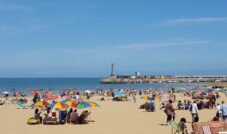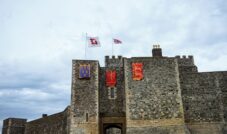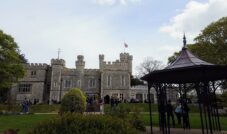Kent has an impressive number of castles which I think are definitely worth visiting whether you have an interest history or not. The structures are impressive, but several of them also have beautiful gardens to stroll around too on a summers day.
I’ve ranked my favourite castles in Kent and provided some history and facts so you can decide if they are worth visiting for you.
Map of Castles in Kent
Jump to section
Hever Castle
You can easily spend a whole day at Hever Castle. There are so many things to see and do aside from the impressive castle. It also has one of the best gardens you can visit in Kent.
A Short History of Hever Castle
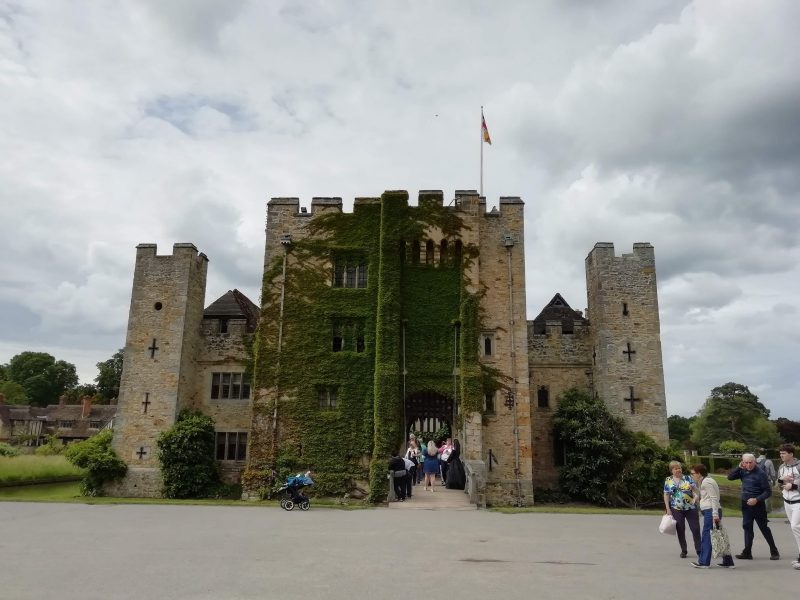
Hever Castle is a romantic moated castle in Kent, best known as the childhood home of Anne Boleyn, the second wife of King Henry VIII. Originally built in 1270 as a country house, it was fortified in the 14th century and later transformed into a Tudor residence by the Boleyn family. Anne lived here until she was sent abroad for education in 1513. Her courtship with Henry VIII partly took place at Hever, and their relationship led to England’s break from the Catholic Church.
After Anne’s execution in 1536, the castle passed to Henry’s fourth wife, Anne of Cleves. Over the centuries, it fell into decline until American millionaire William Waldorf Astor restored it in 1903. He added the Tudor-style Astor Wing and created the Italian Garden to display his sculpture collection. Read my review of Hever Castle.
10 Interesting Facts About Hever Castle
- The castle has England’s oldest working original portcullis.
- Anne Boleyn’s prayer books, signed by her, are on display.
- Henry VIII’s bedroom is recreated with Tudor furnishings.
- The moat surrounds the entire castle and adds to its fairy-tale look.
- The Italian Garden features over 70 classical sculptures.
- The castle was restored using traditional Tudor tools and materials.
- The Astor Wing was built to host guests in Tudor-style cottages.
- The yew maze was planted in 1904 and remains a visitor favourite.
- The castle has been used as a filming location for The Princess Bride and Inkheart.
- Anne Boleyn’s ghost is said to appear near the old oak tree on the anniversary of her death.
Things to See and Do at Hever Castle
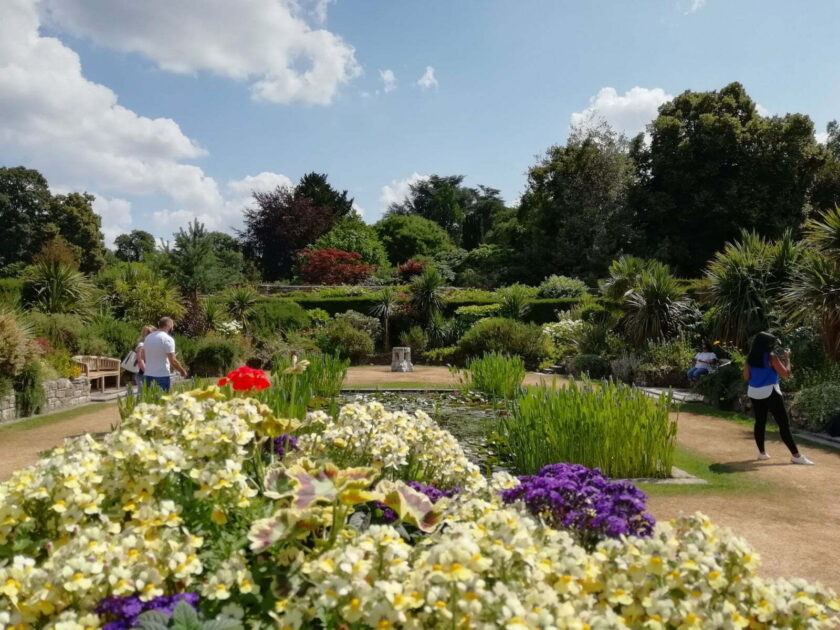
- Tour the Castle Rooms – Explore wood-panelled chambers, roaring fireplaces, and antique furniture. Highlights include the Long Gallery with Tudor portraits, Anne Boleyn’s bedroom, and Henry VIII’s guest room.
- Visit the Book of Hours Room – See Anne Boleyn’s personal prayer books, each bearing her signature. These rare items offer a direct connection to her life and beliefs.
- Walk the Italian Garden – Stroll through formal pathways lined with statues, fountains, and topiary. The garden was designed to showcase Astor’s classical sculpture collection.
- Try the Yew Maze and Water Maze – Navigate the traditional hedge maze or test your balance in the water maze, where stepping stones may squirt water if you choose the wrong path.
- Enjoy the Lake Walk – Take a scenic walk around the 38-acre lake, passing woodland, wildlife, and a Japanese tea house. Boat hire is available in summer.
- Explore the Tudor Towers Playground – Children can climb, slide, and explore a castle-themed play area with towers, bridges, and tunnels.
- Visit the Kent and Sharpshooters Yeomanry Museum – Learn about two local army regiments through uniforms, medals, and interactive displays. The museum is tucked away near the castle entrance.
- Attend Seasonal Events – Enjoy jousting tournaments, open-air theatre, and Christmas festivities. These events add excitement and variety to your visit.
- Browse the Gift and Plant Shops – Pick up souvenirs, books, and locally grown plants. The shops support the castle’s upkeep and offer unique items.
- Relax at the Moat Restaurant or Loggia Bar – Choose from light lunches, cakes, and drinks with views of the gardens or lake. There are also picnic areas throughout the grounds.
Practical Information for Visiting Hever Castle
- Location: Hever Road, Hever, Edenbridge, Kent TN8 7NG
- Website: https://www.hevercastle.co.uk/
- Opening times: Grounds open daily from 10:30 am; castle opens at 12:00 pm; closing times vary seasonally
- Entry: Adults £27.40, children £15.15, family tickets available; discounts for online booking and memberships
- Parking: Free on-site parking included with entry
- Accessibility: Wheelchair access to gardens and ground floor of castle; mobility scooters available to borrow
- Dogs: Allowed on leads in gardens; assistance dogs only inside castle
- Food: Moat Restaurant, Guthrie Pavilion Café, and seasonal kiosks
- Toilets: Accessible toilets and baby-changing facilities available
- Nearby: Chiddingstone Village, Penshurst Place, Chartwell, Groombridge Place
Dover Castle
As a visitor attraction, Dover Castle is one of the best in Kent. Their storytelling through displays transports you back in time to both it’s significant part in battles and as a royal residence. Buying a ticket to visit the bunker is a must.
A short history of Dover Castle
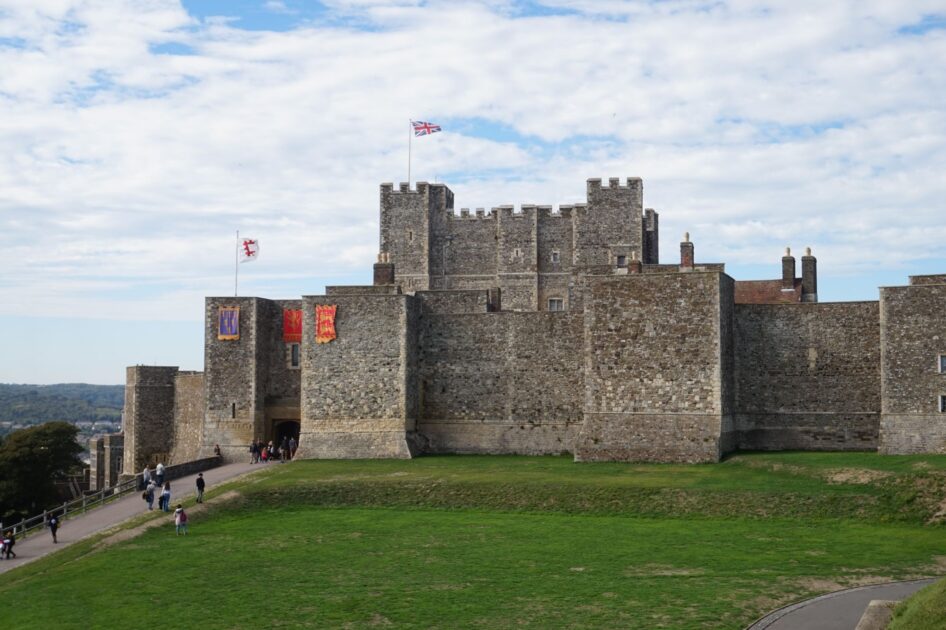
Dover Castle is one of the most important castles in England. It stands on top of the White Cliffs and has protected the country for over 2,000 years. The site was first used by the Romans, who built a lighthouse here. In 1066, William the Conqueror came to Dover after winning the Battle of Hastings and built a fort. Later, King Henry II built the large stone castle we see today. He wanted it to be strong and impressive, both for defence and to welcome important guests.
In the 13th century, the castle was attacked during the First Barons’ War but was never taken. Over time, it was improved to face new threats. During World War II, tunnels under the castle were used to help rescue soldiers from Dunkirk. Read my review of Dover Castle.
10 Interesting Facts About Dover Castle
- The castle has been called the “Key to England” for centuries.
- It has one of the oldest Roman lighthouses in the world.
- The Great Tower was built by King Henry II in the 1180s.
- Eleanor de Montfort defended the castle during a siege in 1265.
- Secret tunnels were used to plan the Dunkirk evacuation in 1940.
- You can still see graffiti made by prisoners from past wars.
- The castle was used as a Cold War bunker in the 1960s.
- The underground hospital shows how soldiers were treated in wartime.
- The castle was never fully conquered in battle.
- On clear days, you can see France from the top.
Things to See and Do at Dover Castle
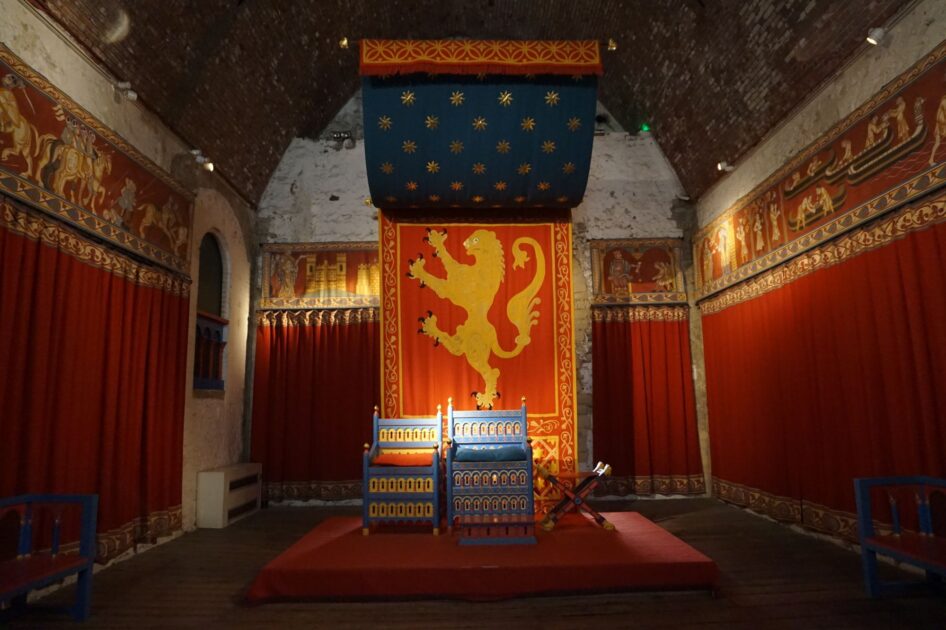
Relax in the Gardens and Picnic Areas – Take a break in the peaceful green spaces around the castle. There are benches and grassy areas where you can enjoy a picnic or simply rest. The views of the sea and surrounding countryside make it a perfect spot to unwind after exploring.
Explore the Great Tower – Step into the heart of the castle and discover how King Henry II lived in the 12th century. The rooms are filled with colourful furniture, wall hangings, and decorations that recreate medieval royal life. Visitors can also climb to the rooftop for sweeping views of the English Channel and Kent countryside.
Walk the Battlements – Stroll along the high stone walls that once protected the castle from attack. From here, you can see the famous White Cliffs and, on clear days, the coast of France. The walk gives a strong sense of the castle’s defensive power and its commanding position over the port of Dover.
Visit the Roman Lighthouse and Saxon Church – See one of the oldest Roman buildings in Britain, built nearly 2,000 years ago to guide ships across the Channel. Next to it stands St Mary-in-Castro, a Saxon church that still holds services today. Together, they show how Dover has been a key site for centuries.
Explore the Secret Wartime Tunnels – Go underground to discover how Dover Castle helped during World War II. These tunnels were used to plan Operation Dynamo, the rescue of soldiers from Dunkirk. The tour includes dramatic sound effects, film clips, and real wartime rooms that bring the story to life.
Tour the Underground Hospital – Walk through a series of rooms that recreate how wounded soldiers were treated during the war. You’ll see hospital beds, medical tools, and kitchens used by staff. The experience gives a vivid picture of wartime care and the challenges faced by doctors and nurses.
Experience Dover Castle Under Siege – This exhibition tells the story of the 1216 siege when French forces tried to capture the castle. Visitors can explore interactive displays, hear battle sounds, and learn how the defenders held out. There’s also a play area for children to enjoy hands-on history.
Try the Escape Room in the Tunnels – Take part in a puzzle-solving adventure set in the wartime tunnels. You and your group must work together to crack codes and escape before time runs out. It’s a fun and challenging way to explore the castle’s underground spaces.
Visit the Regimental Museum – Learn about the Princess of Wales’s Royal Regiment and its role in British military history. The museum includes uniforms, medals, and personal stories from soldiers. It offers insight into the lives of those who served and the regiment’s long connection to Dover.
Watch Live Demonstrations – On special event days, visitors can see falconry displays, medieval combat, and costumed characters. These performances bring history to life and are especially popular with families. Check the castle’s website for upcoming dates and activities.
Practical Information for visiting Dover Castle
- Location: Castle Hill, Dover, Kent CT16 1HU
- Website: https://www.english-heritage.org.uk/visit/places/dover-castle/
- Opening times: Daily, 10:00 am to 5:00 pm (check website for seasonal changes)
- Entry: Adults £22, children £13, family tickets available
- Parking: Free on-site parking
- Access: Some areas have steps and uneven ground; tunnels may not be suitable for all visitors
- Food: Café and tea room on site
- Toilets: Available, including accessible toilets
- Nearby: White Cliffs of Dover, Dover Museum, Samphire Hoe
Scotney Castle
I think Scotney Castle is the most picturesque castles in Kent. Another where you can enjoy walking around the grounds after visiting the castle.
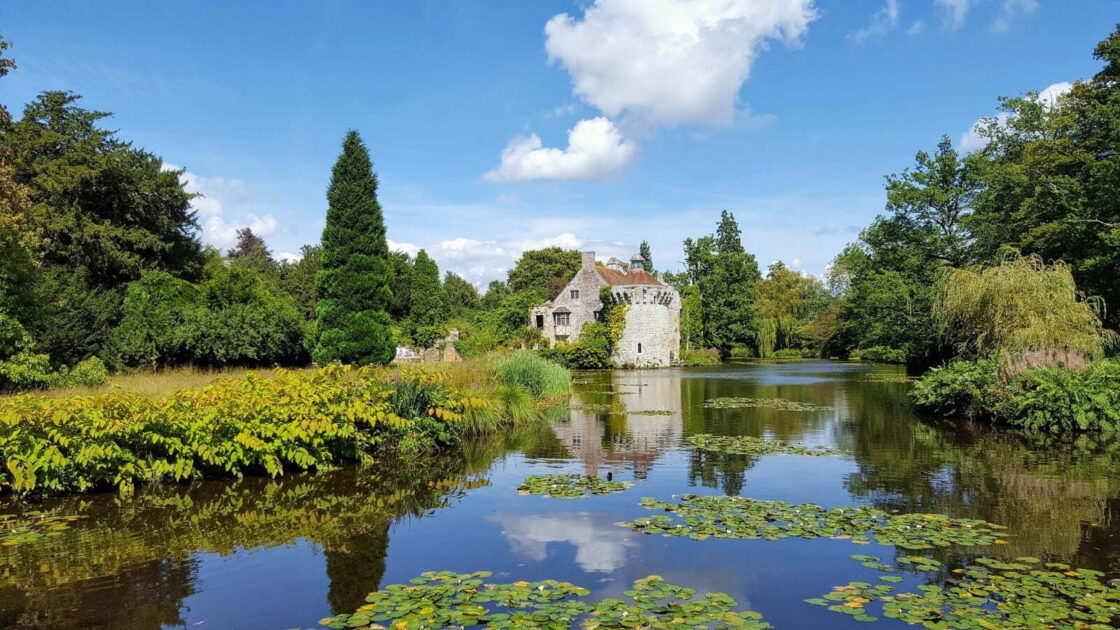
A Short History of Scotney Castle
Scotney Castle is a unique blend of medieval ruins and Victorian elegance, set in a peaceful valley near Lamberhurst. The earliest record of the estate dates to 1137, but the castle itself was built around 1378 by Roger de Ashburnham to defend against French raids. Over time, it became a manor house and was later owned by the Darrell family, who famously hid a Catholic priest in a secret chamber during Elizabethan persecution. In the 1830s, Edward Hussey III built a new house on the hill and transformed the old castle into a romantic ruin to enhance the landscape. The estate remained in the Hussey family until 1970, when it was gifted to the National Trust. Read my review of Scotney Castle.
10 Interesting Facts About Scotney Castle
- The old castle sits on an island surrounded by a moat.
- Only one of the original four towers still stands.
- A secret priest hole is hidden behind a cupboard in the old castle.
- The new house was built using stone quarried from the estate.
- A 100-million-year-old dinosaur footprint was found in the Quarry Garden.
- Margaret Thatcher rented a flat here during her time as Prime Minister.
- The estate hosted evacuees during World War II.
- The gardens are a rare example of a complete Picturesque landscape.
- The house contains a secret door disguised as a bookshelf.
- The castle was used as a filming location for the movie Yanks and the Netflix series The Sandman.
Things to See and Do at Scotney Castle
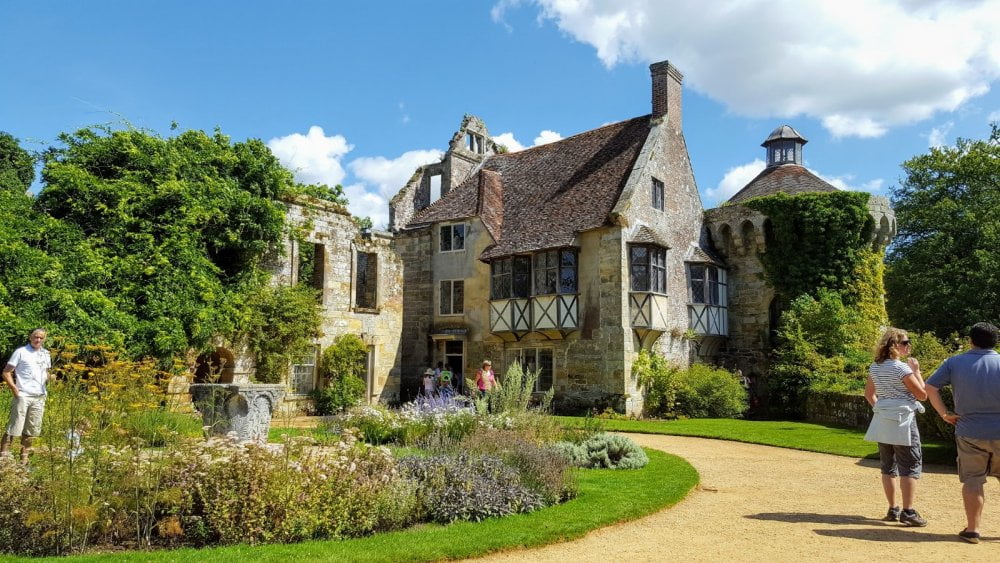
- Explore the Old Castle Ruins – Wander through the romantic remains of the medieval castle, complete with a moat and tower. Look out for the hidden priest hole and enjoy views across the lake.
- Tour the Victorian Mansion – Visit the 19th-century house filled with family collections, period furniture, and quirky features like secret doors and humorous book titles.
- Walk the Gardens – Stroll through 20 acres of landscaped gardens, including the Quarry Garden, woodland glade, and walled kitchen garden. Seasonal blooms include rhododendrons, wisteria, and roses.
- Follow Estate Trails – Choose from several walking routes through 780 acres of parkland and woodland. Trails include the Hop Trail and Parkland Trail, with views of the River Bewl and grazing cattle.
- Visit the Second-Hand Bookshop and Gift Shop – Browse pre-loved books and pick up souvenirs, plants, and local produce.
- Enjoy the Tearoom and Picnic Areas – Relax with a hot meal or snack in the Coach House Tearoom, or bring your own picnic to enjoy in the gardens.
Practical Information for Visiting Scotney Castle
- Location: Lamberhurst, Tunbridge Wells, Kent TN3 8JN
- Website: https://www.nationaltrust.org.uk/visit/kent/scotney-castle
- Opening times: Estate and gardens open daily 10:00–17:00; house and old castle open 11:00–16:30 (seasonal)
- Entry: Adults £19, children £9.50, family tickets available; National Trust members enter free
- Parking: Must be booked in advance; £4.50 for non-members
- Accessibility: Some paths are steep or uneven; mobility scooters and wheelchairs available to borrow
- Dogs: Allowed on leads in gardens and estate; assistance dogs only in house and walled garden
- Food: Tearoom and seasonal kiosks; picnic areas available
- Toilets: Accessible toilets and baby-changing facilities on site
- Nearby: Sissinghurst Castle Garden, Bewl Water, Bedgebury Pinetum
Bodiam Castle
Bodiam Castle looks like the castles you drew as a kid with it’s huge moat and drawbridge. If the inside looks familiar, it was recently a location in Wonka. I recommend walking all the way around the castle to capture every angle.
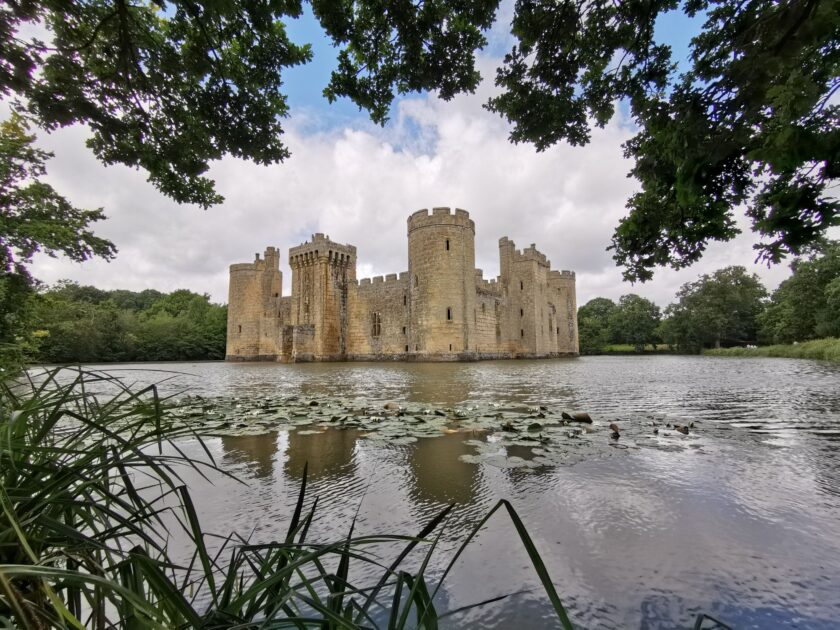
A Short History of Bodiam Castle
Bodiam Castle is one of England’s most iconic medieval castles, known for its wide moat and dramatic towers. It was built in 1385 by Sir Edward Dalyngrigge, a former knight of King Edward III, to defend the area from possible French invasion during the Hundred Years’ War. Dalyngrigge chose a fresh site rather than fortifying his existing manor, creating a quadrangular castle with no central keep. The moat and symmetrical design were as much about status and appearance as defence.
Over the centuries, Bodiam passed through the Dalyngrigge and Lewknor families, survived political upheaval, and was dismantled during the English Civil War. It became a romantic ruin in the 18th century and was restored in stages by later owners, including Lord Curzon, who donated it to the National Trust in 1925. Read my review of Bodiam Castle.
10 Interesting Facts About Bodiam Castle
- Bodiam Castle was built all at once, giving it a consistent architectural style.
- The moat once served as a sewage system for over 30 toilets.
- It has no central keep; rooms are built into the outer walls.
- The castle was never taken by force in battle.
- The portcullis is original and one of the oldest in England.
- Spiral staircases lead to towers with panoramic countryside views.
- The castle was used as a filming location for Monty Python and the Holy Grail.
- Over 800 medieval stonecutter marks have been found on its walls.
- It houses one of the UK’s largest bat maternity roosts.
- Lord Curzon restored the castle and called it “a rare treasure.”
Things to See and Do at Bodiam Castle
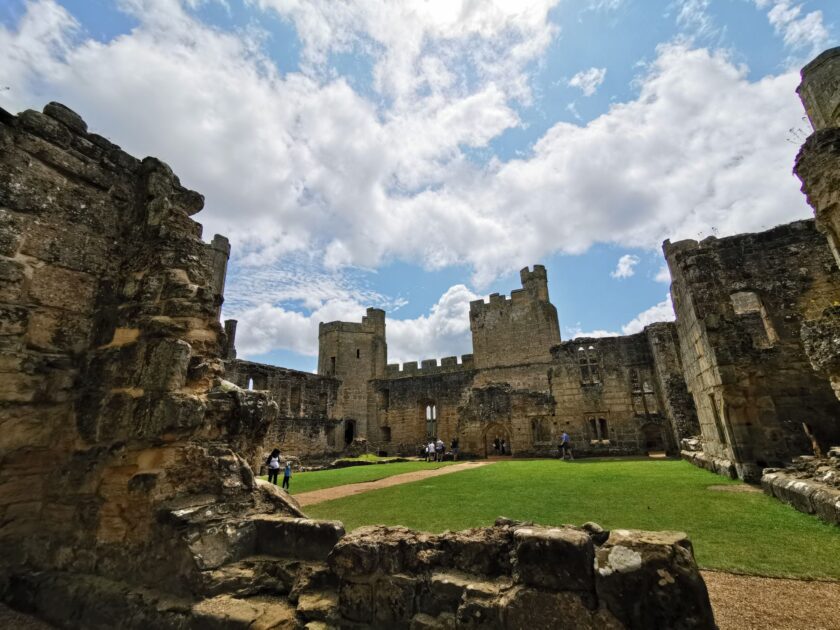
- Walk the Moat Bridge and Gatehouse – Cross the wooden bridge and enter through the imposing gatehouse, complete with arrow slits, murder holes, and the original portcullis. It’s a dramatic start to your visit and sets the tone for the castle’s defensive design.
- Climb the Towers – Ascend steep spiral staircases to reach the tops of the corner towers. From here, you’ll enjoy sweeping views of the River Rother and surrounding countryside. The towers also offer insight into medieval life and lookout strategy.
- Explore the Courtyard and Ruins – Wander through the open courtyard and imagine the layout of the Great Hall, kitchens, chapel, and private chambers. Interpretation boards help you picture how the castle once functioned as a home and fortress.
- Join a Guided Tour or Watch a Film – Learn about Bodiam’s history from knowledgeable guides or watch a short introductory film. These experiences add depth to your visit and highlight key features of the castle.
- Try Archery or Watch Falconry – On event days, visitors can try longbow archery or watch falconry displays. These hands-on activities bring medieval skills to life and are popular with families.
- Spot Wildlife Around the Moat – Look out for ducks, fish, and bats in and around the moat. Bodiam’s natural setting is part of its charm, and wildlife adds another layer to the experience.
- Visit the Gift Shop and Bookshop – Browse castle-themed gifts, local produce, and pre-loved books. It’s a great place to pick up souvenirs or learn more about medieval history.
- Relax at the Wharf Tea Room – Enjoy drinks, light lunches, or homemade cakes with views of the river. It’s a peaceful spot to take a break during your visit.
- Join Seasonal Trails and Activities – During school holidays, children can take part in themed trails, dress-up activities, and storytelling sessions. These events make the castle especially engaging for younger visitors.
- Take a Riverside Walk – Stroll around the grounds and enjoy the landscape, which includes wetlands, grassland, and ancient trees. It’s a scenic way to end your visit.
Practical Information for Visiting Bodiam Castle
- Nearby: Kent & East Sussex Railway, Great Dixter House & Gardens, Bodiam Boating Station
- Website: https://www.nationaltrust.org.uk/visit/sussex/bodiam-castle
- Location: Bodiam, Robertsbridge, East Sussex TN32 5UA
- Opening times: Daily, 10:00 am to 5:00 pm (last entry 30 minutes before closing)
- Entry: Adults £14, children £7, family tickets available; free for National Trust members
- Parking: Free for members; £5 for non-members
- Accessibility: Courtyard accessible; towers via steep stairs; mobility scooter available
- Dogs: Allowed on leads in grounds; assistance dogs only inside castle
- Food: Wharf Tea Room and seasonal Castle View Café
- Toilets: Accessible toilets and baby-changing facilities near car park
Rochester Castle
Unfortunately I can’t find my photos of inside Rochester Castle, but climbing inside the structure is impressive. It’s also worth making time to visit the old town for it’s independent shops, cafes and equally impressive cathedral.
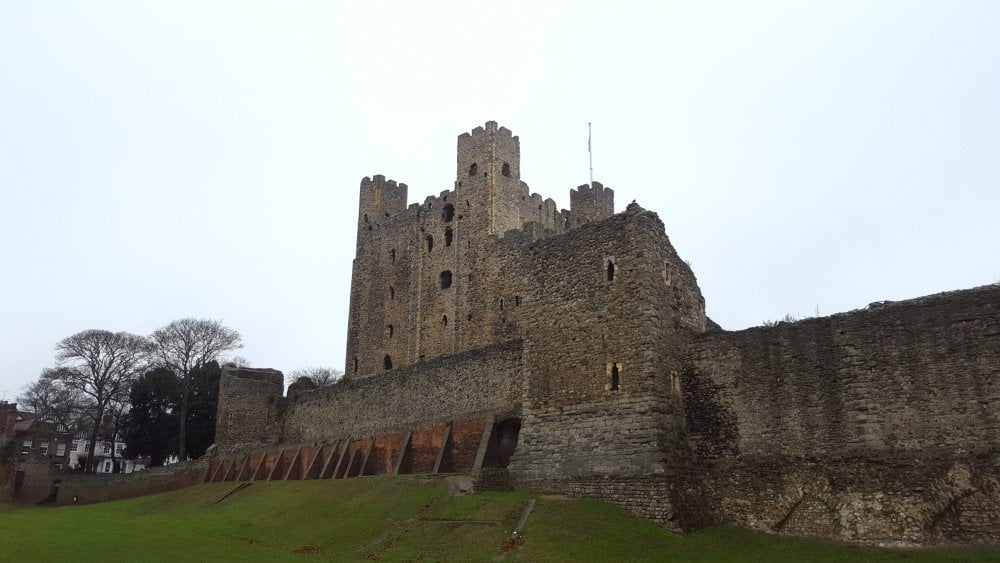
A Short History of Rochester Castle
Rochester Castle is one of the best-preserved Norman castles in England. It stands beside the River Medway and has guarded this strategic crossing since the 11th century. The first castle was built shortly after the Norman Conquest, but the impressive stone keep we see today was added around 1127 by Archbishop William de Corbeil, with support from King Henry I. At 113 feet tall, it remains one of the tallest keeps in England.
The castle played a key role in several major conflicts. In 1215, rebel barons held it against King John, who famously used pig fat to collapse part of the keep during a long siege. It was attacked again in 1264 during the Second Barons’ War and ransacked in the Peasants’ Revolt of 1381. Though it fell into ruin over time, Rochester Castle became a public park in the 19th century and is now a powerful symbol of medieval strength and survival.
10 Interesting Facts About Rochester Castle
- The keep is one of the tallest surviving Norman towers in Europe.
- King John used the fat of 40 pigs to collapse part of the keep during a siege.
- The castle’s southeast corner was rebuilt as a round tower after the 1215 siege.
- Bishop Gundulf, who helped build the Tower of London, also built Rochester Castle.
- Charles Dickens wrote about the castle in The Pickwick Papers and Edwin Drood.
- The castle was never fully destroyed, despite multiple sieges.
- It stands next to Rochester Cathedral, showing the link between crown and church.
- The castle’s well shaft runs through the central wall, allowing water access on every floor.
- The castle was used as a prison and barracks in later centuries.
- Visitors can now experience medieval smells through interactive scent stations.
Things to See and Do at Rochester Castle
- Climb the Keep – Ascend the spiral staircases to explore the castle’s towering keep. You’ll find dramatic views over the River Medway and Rochester’s historic skyline. Interpretation panels help you imagine how the rooms were once used.
- Walk the Castle Grounds – Stroll through the open green spaces that surround the keep. These gardens were laid out in the 19th century and offer a peaceful place to relax, picnic, or enjoy seasonal events.
- Discover the Siege Stories – Learn about the dramatic sieges of 1215 and 1264 through displays and storytelling. The castle’s damaged walls and rebuilt tower show how warfare shaped its structure.
- Visit the Scent Stations – Experience medieval life through smell. Stations recreate the aromas of castle kitchens, chapels, and even the cesspit, offering a vivid sensory journey into the past.
- Explore Nearby Attractions – Combine your visit with Rochester Cathedral, the Guildhall Museum, and Eastgate House. All are within walking distance and add depth to the castle’s story.
Practical Information for Visiting Rochester Castle
- Location: Castle Hill, Rochester, Kent ME1 1SW
- Website: https://www.english-heritage.org.uk/visit/places/rochester-castle/
- Opening times: 1 April – 30 September: 10:00 am – 6:00 pm; 1 October – 31 March: 10:00 am – 4:00 pm
- Entry: Adults £8.50, children £5.00, concessions £7.60, family tickets available; free for English Heritage members
- Parking: No on-site parking; nearest is Boley Hill Car Park (pay and display)
- Accessibility: Steep stairs and uneven surfaces; limited access for wheelchairs
- Toilets: Located in the castle gardens
- Food: No café on site; plenty of options nearby on Rochester High Street
- Dogs: Allowed on leads in the grounds; assistance dogs only inside the keep
- Nearby: Rochester Cathedral, Guildhall Museum, Eastgate House, Upnor Castle
Sissinghurst Castle
A very small castle compared to the rest on this list, but the gardens are enjoyable to walk around.
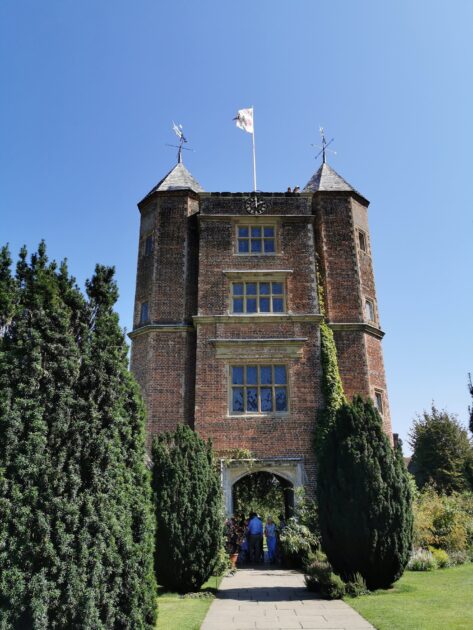
A Short History of Sissinghurst Castle
Sissinghurst Castle is one of Kent’s most famous and romantic historic sites. The name “Sissinghurst” comes from Saxon roots, and the estate has been occupied since at least the 12th century. In the 1530s, Sir Richard Baker built a grand Tudor house here, which later hosted Queen Elizabeth I in 1573. Over time, the estate fell into decline and was used as a prison for French sailors during the Seven Years’ War. The name “castle” was adopted during this period, though it was never a true fortress.
In 1930, poet and writer Vita Sackville-West and her husband Harold Nicolson bought the property and transformed it into a world-famous garden. Vita focused on planting, while Harold designed the layout. Their work created a series of garden “rooms” filled with colour and character. Today, Sissinghurst Castle is celebrated for its literary history, stunning views, and one of the most influential gardens in England.
10 Interesting Facts About Sissinghurst Castle
- The garden was designed as a series of “rooms” with different themes.
- The White Garden is one of the most famous garden designs in the world.
- Queen Elizabeth I stayed at Sissinghurst in 1573.
- The tower was built in the 1560s and was Vita’s writing retreat.
- The estate was once a prisoner-of-war camp for 3,000 French sailors.
- Vita Sackville-West wrote a gardening column for The Observer from her tower.
- The gardens were first opened to the public in 1938 for one shilling.
- The moat is a surviving feature from the original Tudor house.
- The Delos Garden was inspired by Vita and Harold’s visit to a Greek island.
- The estate covers over 450 acres of farmland, woodland, and lakes.
Things to See and Do at Sissinghurst Castle
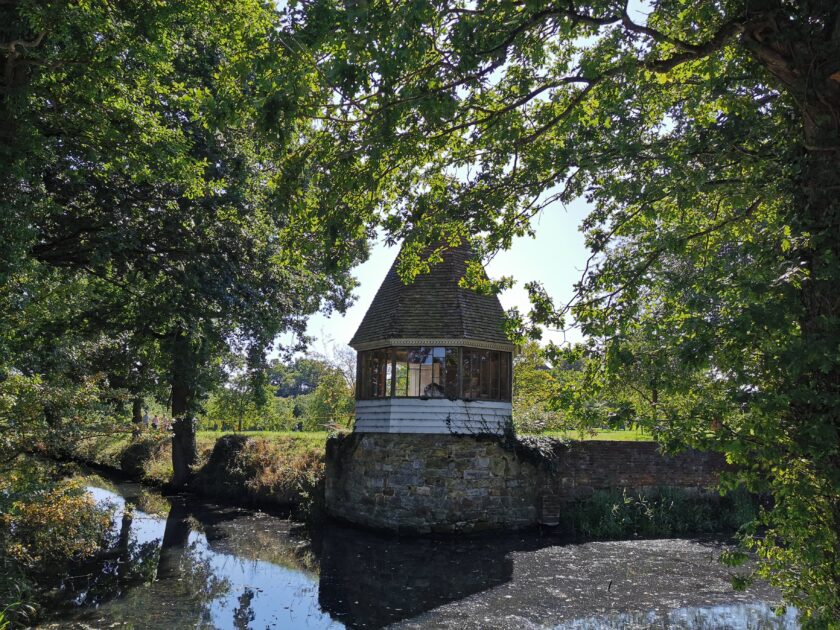
- Climb the Elizabethan Tower – Walk up 78 steps to reach Vita Sackville-West’s writing room and enjoy panoramic views of the gardens and countryside. The room is preserved as she left it, offering a glimpse into her creative world.
- Explore the Garden Rooms – Wander through themed areas like the White Garden, Rose Garden, Cottage Garden, and Lime Walk. Each space has its own mood and planting style, designed to surprise and delight visitors.
- Visit the Big Room (Library) – Step into the atmospheric library where Vita and Harold entertained guests. It now hosts exhibitions about their lives, writing, and garden design.
- Walk the Estate Trails – Choose from several walking routes across 450 acres of farmland and woodland. Trails include views of the lakes, hop gardens, and historic farm buildings.
- Browse the Plant Shop and Bookshop – Pick up plants grown on-site, gardening books, and second-hand reads. It’s a great way to take a piece of Sissinghurst home with you.
- Relax in the Granary Restaurant or Old Dairy Café – Enjoy seasonal meals made with produce from the estate’s organic vegetable garden. There’s indoor and outdoor seating for a peaceful break.
- Discover the Delos Garden – Inspired by a Greek island, this dry garden features Mediterranean plants, rocks, and gravel. It’s a newer addition that reflects Vita and Harold’s travels.
- Explore the Vegetable Garden – See how fruit, herbs, and vegetables are grown using organic methods. Produce is used in the café and sold in the shop.
- Join a Guided Tour or Seasonal Event – Learn more about the history and design of Sissinghurst through expert-led tours, exhibitions, and family-friendly activities.
- Enjoy Wildlife and Lakeside Views – Spot birds, butterflies, and wildflowers around the estate’s lakes and meadows. It’s a peaceful way to connect with nature.
Practical Information for Visiting Sissinghurst Castle
- Location: Biddenden Road, near Cranbrook, Kent TN17 2AB
- Website: https://www.nationaltrust.org.uk/visit/kent/sissinghurst-castle-garden
- Website: https://www.nationaltrust.org.uk/visit/kent/sissinghurst-castle-garden
- Opening times: Garden 11:00–17:30; Estate 10:00–17:30; Tower and Library 11:00–17:00
- Entry: Adults £19, children £9.50, family tickets available; free for National Trust members
- Parking: £4 for non-members; free for members
- Accessibility: Some areas have uneven paths and steps; wheelchairs available to borrow
- Dogs: Allowed on leads in the wider estate; not in the formal garden
- Food: Granary Restaurant and Old Dairy Café on site
- Toilets: Accessible toilets and baby-changing facilities available
- Nearby: Cranbrook town, Bedgebury Pinetum, Great Dixter House & Gardens
Whitstable Castle and Gardens
There are so many things to see and do in Whitstable, it can be easy to give this a miss. The cafe and setting outside makes it worth visiting I think.
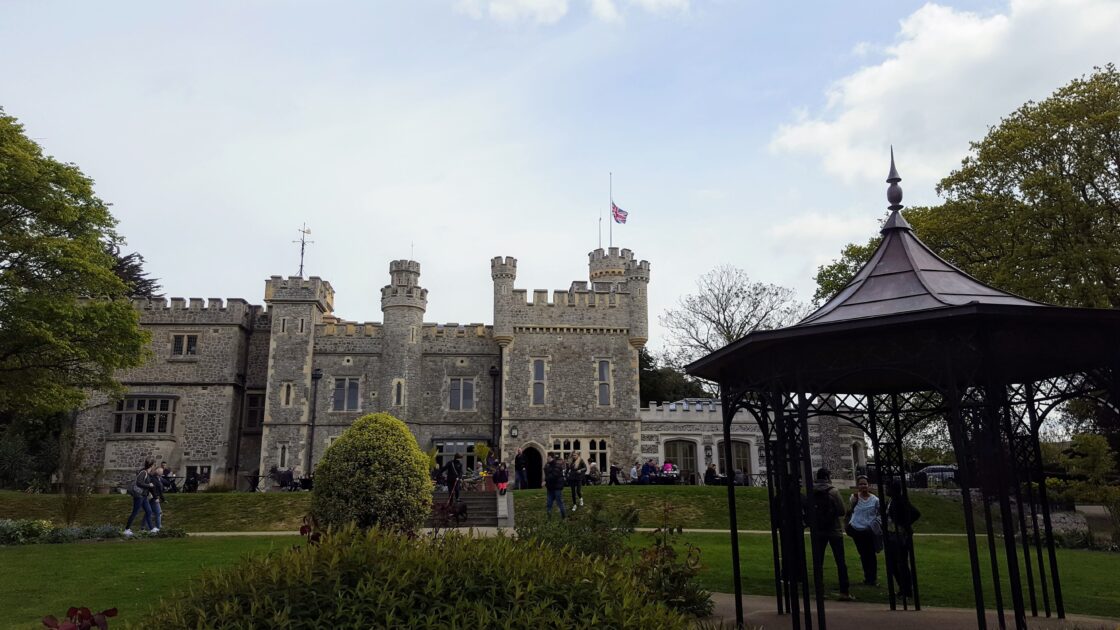
A Short History of Whitstable Castle and Gardens
Whitstable Castle, originally known as Tankerton Towers, began life in the late 18th century as a private home built by Charles Pearson, a London businessman. He used bricks from the declining copperas industry to construct an octagonal tower on the site. Over time, the property was expanded and improved by various owners, most notably Wynn Ellis, a wealthy silk merchant and Member of Parliament. Ellis added wings, lodges, and landscaped gardens, turning the estate into a grand summer retreat.
In the 20th century, the castle served as council offices before becoming a community venue. Thanks to local efforts and lottery funding, the gardens were restored and the building was reopened to the public. Today, Whitstable Castle is a popular spot for weddings, events, and quiet visits. Though not a traditional fortress, it remains one of Whitstable’s most charming landmarks, offering a blend of local history, seaside views, and peaceful gardens.
10 Interesting Facts About Whitstable Castle and Gardens
- The castle was built using bricks from Whitstable’s copperas smelting works.
- Wynn Ellis added a bell tower, lodges, and a conservatory in the 1840s.
- The estate once stretched from Bennells Avenue to Oxford Street.
- The Pearson’s Arms pub began as a railway station built by Charles Pearson.
- The gardens include an ice house, summerhouses, and ornamental borders.
- The Almshouses near the gate were built by Ellis in memory of his wife.
- The castle was used as council offices from 1935 to 1975.
- The gardens opened to the public in 1948.
- The Orangery Tearoom was added during recent renovations.
- The castle is now managed by a charitable trust and hosts community events.
Things to See and Do at Whitstable Castle and Gardens
- Stroll Through the Gardens – Enjoy a peaceful walk among rose beds, herbaceous borders, and manicured lawns. The gardens are well maintained and offer sea views, benches, and picnic spots.
- Visit the Orangery Tearoom – Relax with tea, coffee, or lunch in a bright and welcoming tearoom overlooking the gardens. It’s a great place to unwind after exploring.
- Explore the Heritage Display – Learn about the castle’s history through photos and exhibits that tell the story of its transformation from industrial site to elegant home.
- Attend Seasonal Events – Join in local celebrations such as Easter trails, summer fairs, and Christmas markets. These events are family-friendly and bring the community together.
- Enjoy the Children’s Play Area – Let younger visitors enjoy the imaginative play space with natural materials, sand, and water features. It’s designed for children under 8.
- Take Part in a Guided Tour – Groups can book a cream tea and guided tour to learn more about the castle’s architecture and past residents.
- Book a Wedding or Private Event – The castle is a popular venue for weddings and celebrations, offering indoor and outdoor spaces with historic charm.
- Relax on the Sun Terrace – Sit outside and enjoy the fresh sea air with views across the Thames Estuary. It’s a quiet spot for reading or chatting.
- Browse the Gift Shop – Pick up souvenirs, local crafts, and seasonal items. The shop supports the castle’s upkeep and community work.
- Explore Nearby Attractions – Combine your visit with a walk to Whitstable Harbour, Tankerton Slopes, or the town’s independent shops and galleries.
Practical Information for Visiting Whitstable Castle and Gardens
- Location: Tower Hill, Whitstable, Kent CT5 2BW
- Website: https://www.whitstablecastle.co.uk/
- Opening times: Gardens open daily 8:00 am – 6:00 pm; Tearoom open 9:00 am – 4:00 pm (5:00 pm in summer)
- Entry: Free
- Parking: Free on-site parking; register your car at reception to avoid fines
- Accessibility: Gardens mostly accessible; castle interior limited; wheelchairs available to borrow
- Dogs: Allowed on leads in gardens; not inside the building
- Food: Orangery Tearoom offers drinks, cakes, and light meals
- Toilets: Available, including accessible facilities
- Nearby: Whitstable Harbour, Tankerton Beach, The Street, Whitstable Museum
Read guide on the best things to see, do and eat in Whitstable.
Upnor Castle
Another small castle to visit, but it’s also worth visiting the pretty surrounding area.
A Short History of Upnor Castle
Upnor Castle is a rare example of an Elizabethan artillery fort, built between 1559 and 1567 on the orders of Queen Elizabeth I. It was designed to protect Royal Navy warships anchored in the River Medway near Chatham Dockyard. The castle’s triangular gun platform and riverside location made it ideal for defending the fleet from attack.
Despite its strong design, Upnor Castle failed to stop the Dutch during a surprise raid in 1667. The Dutch fleet sailed past the castle and destroyed or captured many English ships, exposing weaknesses in England’s coastal defences. After this, Upnor lost its role as a frontline fort and became a naval ammunition depot, storing gunpowder and weapons for the fleet.
The castle remained in military use until 1945 and is now open to the public. Its riverside setting, historic architecture, and dramatic story make it a fascinating place to explore.
10 Interesting Facts About Upnor Castle
- The castle was built using stone from nearby ruined buildings, including Rochester Castle.
- Its gun platform was shaped like an arrowhead to fire at ships from multiple angles.
- The 1667 Dutch raid is one of the worst defeats in Royal Navy history.
- A defensive chain was once stretched across the river to block enemy ships.
- The castle stored gunpowder and ammunition for over 250 years.
- King James I and Christian IV of Denmark dined aboard a ship moored at Upnor in 1606.
- The castle’s towers were later adapted to house troops.
- It was used as a base for bomb disposal teams during World War II.
- The gatehouse and moat were added during later upgrades.
- Today, Upnor Castle is managed by Medway Council and hosts weddings and events.
Things to See and Do at Upnor Castle
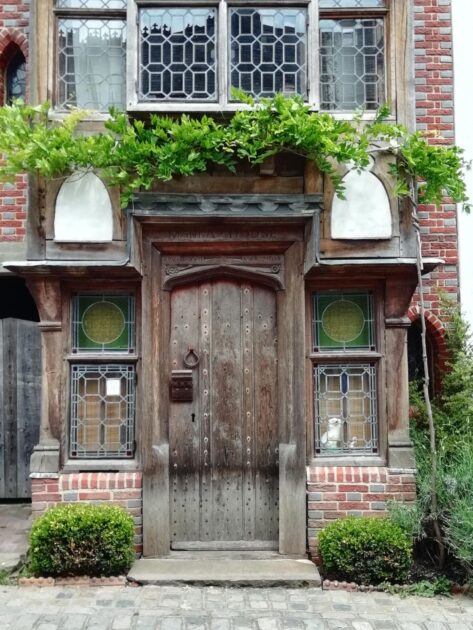
- Explore the Castle Interior – Walk through the gatehouse and into the main building to see vaulted rooms, stone staircases, and historic displays. Interpretation boards and a short film explain the castle’s role in defending the Medway.
- Visit the Water Bastion – Stand on the triangular gun platform that once protected the river. Its shape allowed cannons to fire in multiple directions, and the views across the Medway are still impressive today.
- Discover the Dutch Raid Exhibition – Learn about the dramatic 1667 attack through audio-visual displays and storytelling. The exhibition shows how the Dutch breached the defences and what happened during the raid.
- Explore the Towers and Tunnels – Climb the North and South Towers for views and explore basement tunnels that were once used for storage and defence. These areas offer a glimpse into the castle’s military life.
- Enjoy the Castle Grounds – Relax in the quiet gardens surrounding the castle. There are benches and picnic spots, and the riverside setting makes it a peaceful place to unwind.
- Join Seasonal Events and Reenactments – Look out for summer theatre, pirate days, and military reenactments. These events bring history to life and are popular with families.
- Take a Guided Tour – Book a guided tour to hear stories about the castle’s construction, battles, and daily life. Tours often include cream tea and are ideal for groups.
- Browse the Gift Shop – Pick up souvenirs, snacks, and local items at the small shop near the entrance. It also offers drinks and ice cream.
- Visit Nearby Pubs and Walks – After your visit, explore the cobbled streets of Upper and enjoy a meal at one of the village’s historic pubs. There are also walking trails along the river.
- Attend a Wedding or Private Event – Upnor Castle is available for hire and offers a romantic setting for weddings and celebrations. The riverside views and historic backdrop make it a memorable venue.
Practical Information for Visiting Upnor Castle
- Location: Upnor Road, Upper Upnor, Rochester, Kent ME2 4XG
- Website: https://www.english-heritage.org.uk/visit/places/upnor-castle/
- Opening times: April to September, Wednesday to Sunday, 10:00 am – 6:00 pm; October, 10:00 am – 4:00 pm; closed November to March
- Entry: Adults £8.50, children £4.00, concessions £6.50, family tickets £21; free for English Heritage members
- Parking: Free car park in Upper Upnor; no parking at the castle itself
- Accessibility: Limited access due to stairs and uneven surfaces; wheelchair access to lower areas only
- Toilets: Available on site, including baby-changing facilities
- Food: No café, but vending machine and nearby pubs offer meals and drinks
- Dogs: Assistance dogs only inside; dogs allowed on leads in the grounds
- Nearby: Rochester Castle, Chatham Dockyard, Copper Rivet Distillery, Upnor Beach
Chiddingstone Castle
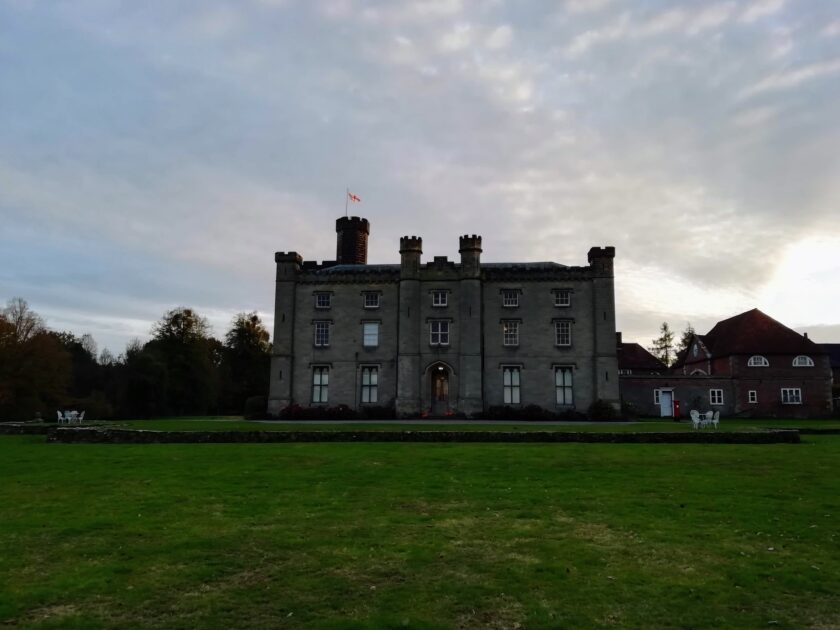
A Short History of Chiddingstone Castle
Chiddingstone Castle is a historic country house with Tudor origins, located in the village of Chiddingstone near Edenbridge. The original timber-framed house was built in the early 16th century by Richard Streatfeild, a wealthy ironmaster and wool merchant. It was rebuilt in brick in 1679 and later remodelled in the early 1800s to resemble a medieval castle with battlements and towers. The Streatfeild family owned the estate until 1938, after which it served various roles, including a wartime base and a school.
In 1955, antiques dealer Denys Eyre Bower purchased the castle to house his personal collections. Despite a dramatic legal scandal, he continued to live at the castle and open it to the public until his death in 1977. His collections remain on display today. The castle is now managed by a charitable trust and offers visitors a unique mix of architecture, history, and world cultures in a peaceful countryside setting.
10 Interesting Facts About Chiddingstone Castle
- The castle was once called High Street House before its Gothic makeover.
- Denys Eyre Bower’s collections include Japanese, Egyptian, Buddhist, and Jacobite artefacts.
- The castle’s lake held the UK record for largest bream for 37 years.
- A secret passage connects the castle to the village church.
- The Victorian kitchen still has its original cake ovens and ice chest.
- The orangery and gazebo are listed buildings from the early 1800s.
- The castle hosted Canadian troops during World War II.
- Bower’s Buddhist collection reflects his personal beliefs.
- The castle’s grounds include a maze inspired by Ancient Egypt.
- The castle is not part of the National Trust but is a member of Historic Houses.
Things to See and Do at Chiddingstone Castle
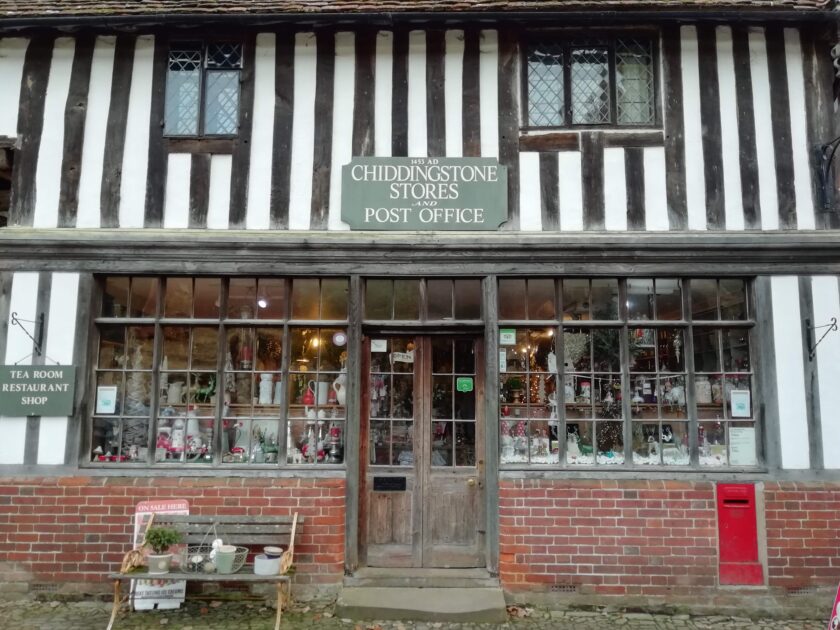
- Explore the Castle Rooms – Visit the Great Hall, Victorian Kitchen, Library, and Servants’ Quarters. Each room is filled with period features and objects from Denys Eyre Bower’s collections.
- Discover the Museum Collections – See rare items from Ancient Egypt, Japan, Buddhist cultures, and British history. Highlights include samurai armour, ushabti figures, and Jacobite manuscripts.
- Walk the Grounds and Gardens – Enjoy 35 acres of lawns, woodland, and lakeside paths. The grounds include a rose garden, Victorian orangery, and an Egyptian-themed maze.
- Relax in the Tea Room – Have lunch, cream tea, or homemade cake in the courtyard or walled garden. Afternoon tea is available by booking and includes prosecco options.
- Fish at the Castle Lake – Try your luck at the 3.5-acre lake, stocked with carp, bream, and perch. Fishing is available daily with a small fee.
- Attend Seasonal Events – Join vintage fairs, open-air theatre, music afternoons, and Christmas markets. Events are family-friendly and often include food and entertainment.
- Take a Guided Tour – Book a highlights or in-depth tour to learn about the castle’s history and collections. Tours are available for groups and include refreshments.
- Visit the Gift Shop – Browse books, souvenirs, and locally made items. The shop is located in the tower and accessible without castle admission.
- Explore the Village of Chiddingstone – Walk across the lake bridge to reach one of Kent’s best-preserved Tudor villages. Visit the Castle Inn, St Mary’s Church, and the Chiding Stone.
- Enjoy Wildlife and Views – Spot ducks, herons, and butterflies around the lake and gardens. The castle’s elevated position offers views across the Kent countryside.
Practical Information for Visiting Chiddingstone Castle
- Location: Hill Hoath Road, Chiddingstone, Edenbridge, Kent TN8 7AD
- Website: https://www.chiddingstonecastle.org.uk/
- Opening times: Castle, Tea Room, and Gift Shop open Wednesday to Sunday, 11:00 am – 5:00 pm (March to October); last entry 4:15 pm
- Entry: Adults £11, children £5.50, family tickets available; grounds free with £3 parking donation
- Parking: On-site; £3 suggested donation in honesty box
- Accessibility: Wheelchair access to ground floor and gardens; uneven paths in some areas
- Dogs: Allowed on leads in grounds; assistance dogs only inside castle
- Food: Tea Room offers light meals, cakes, and afternoon tea
- Toilets: Available, including accessible facilities
- Nearby: Hever Castle, Penshurst Place, Chartwell, Toys Hill
Here are three castles I’m looking forward to visiting Walmer Castle, Deal Castle and Leeds Castle this year!
Next, read my guide on fun things to do in Kent.
More guides on Kent
- Where Are The Oldest Castles In Kent?
- Brilliant Things To See, Do And Eat In Folkestone
- Best Things To See, Do & Eat In Faversham
- A Guide To Kent’s Sandy Beaches (And What To See And Do Afterwards)
- Best Coastal Towns In Kent
- 48 Hours In Margate – Fun & Unique Things To Do
- In Photos: Why Dungeness Is Worth Visiting – Things To Do & History
- In Photos: A Walk Around Samphire Hoe Country Park & Beach
- Best Places To Eat And Shop in Broadstairs
- Visit Edenbridge: Ultimate Guide To Things To Do
- Best Things To See, Do And Eat In Deal







